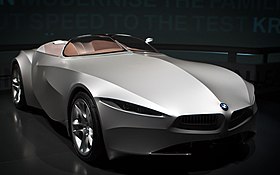
Steering is the control of the direction of locomotion.

The BMW Z3 is a range of two-seater sports cars which was produced from 1995 to 2002. The body styles of the range are:

The BMW E12 is the first generation of 5 Series executive cars, which was produced from 1972 to 1981 and replaced the saloon models of the BMW New Class range.
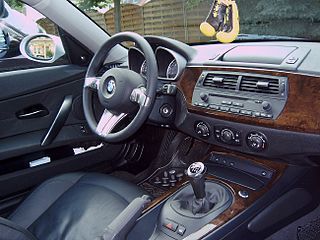
The first generation of the BMW Z4 consists of the BMW E85 and BMW E86 sports cars. The E85/E86 generation was produced from 2002 to 2008. The E85/E86 replaced the Z3 and is the third model in the BMW Z Series. Initial models were in the roadster (E85) body style, with the coupé (E86) body style being added in 2006. In February 2009, the BMW Z4 (E89) began production as the successor to the E85/E86.

The BMW M3 is a high-performance version of the BMW 3 Series, developed by BMW's in-house motorsport division, BMW M GmbH. M3 models have been produced for every generation of 3 Series since the E30 M3 was introduced in 1986.

The BMW M5 is a high performance variant of the BMW 5 Series marketed under the BMW M sub-brand. It is considered an iconic vehicle in the sports sedan category. The majority of M5s have been produced in the sedan (saloon) body style, but in some countries the M5 was also available as a wagon (estate) from 1992 to 1995 and from 2006 to 2010.
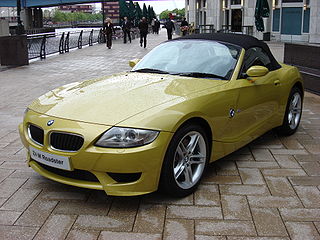
The BMW M Coupé and BMW M Roadster are high performance models of the BMW Z3 and Z4 coupés/roadsters produced by BMW M. The first generation was based on the Z3 and was produced between 1998 and 2002. The second generation was based on the Z4 and was produced between 2006 and 2008.

The BMW M4 is a high-performance version of the BMW 4 Series coupés and convertibles developed by BMW's motorsport division, BMW M, and marketed since 2014.
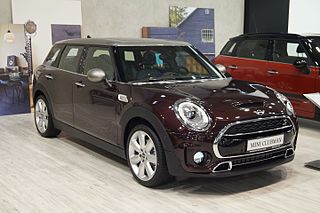
The Mini Clubman is a subcompact executive car engineered and manufactured by BMW and sold under the Mini marque. The first-generation Clubman was introduced in 2007, as a variant of the Mini Hatch. A commercial version called Clubvan was added to the range in 2012. The current second-generation model is produced since 2015 and available with front- and all-wheel drive.

The BMW X6 is a mid-size luxury crossover SUV by German automaker BMW. The BMW X6 is the originator of the sports activity coupé (SAC), referencing its sloping rear roof design. It combines the attributes of an SUV with the stance of a coupé. It is built in BMW's North American plant in Greer, South Carolina alongside the BMW X5, whose platform it shares. Prior to the release of the X7, the X6 was considered a flagship SUV for BMW.

The BMW Z9 is a four-seat coupe concept car, carbon-fiber skin over an aluminum space frame. It was introduced on September in 1999 at the Frankfurt Auto Show. During the 2000 Paris Auto Show a convertible variant of the Z9 was debuted. It was designed by Adrian van Hooydonk under manage of Chris Bangle, who was promoted to Director of BMW Group Design. Much of the styling found on E63 6 series is derived from the Z9.
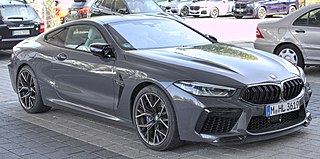
The BMW M8 is the high performance version of the BMW 8 Series (G15) marketed under the BMW M sub-brand.

The BMW X1 is a line of cars produced by German marque BMW since 2009. It is in the subcompact luxury crossover class, and the first-generation X1 was based on the E90 3 Series and offered rear-wheel drive layout as standard. At its introduction in 2009, it was positioned as the smallest SUV in BMW line-up, below the X3 prior to the launch of the smaller X2. The X1 essentially is aiming a wider range of customers due to its smaller size, increased efficiency, and a lower price tag due to the all-wheel drive layout (xDrive) being optional.

The Vision ConnectedDrive is a two-seater sports car concept built by BMW featuring new advanced driver assistance aids. It had its world premiere at the 2011 Geneva Motor Show. Unlike previously named Vision concept cars, BMW has no intention to build this vehicle, but to show off its latest design and technology developments.

The Mini Hatch, stylised as MINI Hatch, also sold as Mini Cooper, Mini One, or simply called the (BMW) Mini, are a family of retro-styled two-door supermini hatchback and convertible; and a longer, subcompact 4/5-door hatchback. They were introduced in early 2000 by German automaker BMW under the 'Mini' brand. The second generation was launched in 2006 and the third, adding a longer 4/5-door hatchback, in 2014. A two-door convertible version was added in 2004, followed by its second generation in 2008.

The BMW X2 is a subcompact luxury crossover SUV produced by BMW. It was first showcased as the BMW Concept X2 at the 2016 Paris Motor Show, with a production version unveiled in October 2017. Sales commenced in March 2018. It is considered a sportier and less practical alternative to the X1, as is the case with other even-numbered X models with its respective counterparts.
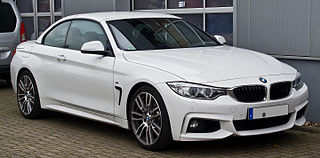
The first generation of the BMW 4 Series consists of the BMW F32, BMW F33 and BMW F36 compact executive cars. The F32/F33/F36 was produced from 2014 to 2020 and is often collectively referred to as the F32.

The BMW X7 is a full-sized luxury sport utility vehicle manufactured by BMW. It is BMW's largest and most expensive SUV in its line-up.

The E84 BMW X1 is a subcompact crossover SUV/C-segment model was produced from 2009 to 2015. It is the first generation model of the BMW X1 range, and was replaced by the F48 BMW X1 in mid-2015.
A four-dimensional product considers a physical product as a life-like entity capable of changing form and physical properties autonomously over time. It is an evolving field of product design practice and research linked to similar concepts at the material scale, however, typically utilizes sensors and actuators in order to respond to environmental and human conditions, modifying the shape, color, character and other physical properties of the product. In this way 4D products share similarities with responsive architecture, at the more human scale associated with products.
